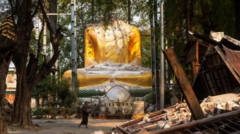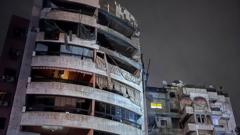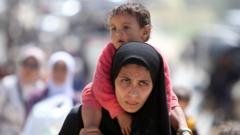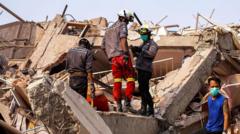As the toll rises, locals are resorting to digging through rubble with their bare hands, hampered by a lack of resources and communication.
Myanmar Earthquake Casualties Surge Above 1,600 Amidst Desperate Rescue Efforts
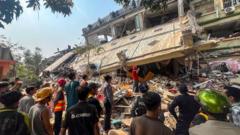
Myanmar Earthquake Casualties Surge Above 1,600 Amidst Desperate Rescue Efforts
The devastating earthquake in Myanmar leaves communities grappling with loss, while search and rescue teams struggle to reach trapped victims.
The recent earthquake in Myanmar has led to a significant rise in casualties, with the death toll surpassing 1,600 souls as rescue efforts intensify. Communities affected by the disaster are facing dire circumstances, with many individuals relying on sheer determination, digging through the devastation with their bare hands to unearth survivors. Amidst the chaos, the search for trapped individuals is severely undermined by inadequate equipment and disrupted communication networks, which are essential for coordinating rescue efforts.
Mandalay, the second-largest city, has been especially hard-hit, with extensive damage reported. A heartwarming moment was witnessed when rescuers successfully pulled a woman from the ruins of a 12-storey apartment building, around 30 hours after its collapse, yet the Red Cross estimates that over 90 individuals remain trapped. In a grim discovery, the bodies of 12 preschool children and their teacher were recovered from the wreckage of a kindergarten.
International aid has begun to trickle into the country, but many of the most affected areas remain isolated. Local residents have turned into makeshift rescue teams, oftentimes moving rubble without any specialized tools. Footage circulating online shows volunteers cooperating to free a young woman pinioned between concrete slabs while pleas for help echoed from below the debris.
Rescue teams have reported that they are often left guessing where to go next due to communication breakdowns, further complicating efforts. A local resident recounted how coordination among rescuers was almost nonexistent, worsening the crisis, as overwhelmed hospitals struggled to manage the influx of casualties.
In light of the disaster, the junta has reported that the earthquake damaged over 1,500 buildings in the Mandalay region. Power outages are persisting, with officials warning that electricity restoration could take several days. Mandalay airport is also out of service, forcing a temporary hospital and shelter to be established on-site.
The situation in the region is complicated by ongoing military operations; the junta has reportedly launched air strikes against ethnic groups, even as the appeal for international aid was made. Reports surfaced of attacks occurring shortly after the earthquake, leaving many to question the focus of the authorities amidst a humanitarian crisis.
The UN's special rapporteur on human rights in Myanmar, Tom Andrews, has made an urgent appeal for the junta to cease military operations, condemning ongoing air strikes as "outrageous and unacceptable.” The deteriorating conditions in the aftermath of this disaster are compounded by conflict, leaving communities yearning for a reprieve and the chance to rebuild.
Mandalay, the second-largest city, has been especially hard-hit, with extensive damage reported. A heartwarming moment was witnessed when rescuers successfully pulled a woman from the ruins of a 12-storey apartment building, around 30 hours after its collapse, yet the Red Cross estimates that over 90 individuals remain trapped. In a grim discovery, the bodies of 12 preschool children and their teacher were recovered from the wreckage of a kindergarten.
International aid has begun to trickle into the country, but many of the most affected areas remain isolated. Local residents have turned into makeshift rescue teams, oftentimes moving rubble without any specialized tools. Footage circulating online shows volunteers cooperating to free a young woman pinioned between concrete slabs while pleas for help echoed from below the debris.
Rescue teams have reported that they are often left guessing where to go next due to communication breakdowns, further complicating efforts. A local resident recounted how coordination among rescuers was almost nonexistent, worsening the crisis, as overwhelmed hospitals struggled to manage the influx of casualties.
In light of the disaster, the junta has reported that the earthquake damaged over 1,500 buildings in the Mandalay region. Power outages are persisting, with officials warning that electricity restoration could take several days. Mandalay airport is also out of service, forcing a temporary hospital and shelter to be established on-site.
The situation in the region is complicated by ongoing military operations; the junta has reportedly launched air strikes against ethnic groups, even as the appeal for international aid was made. Reports surfaced of attacks occurring shortly after the earthquake, leaving many to question the focus of the authorities amidst a humanitarian crisis.
The UN's special rapporteur on human rights in Myanmar, Tom Andrews, has made an urgent appeal for the junta to cease military operations, condemning ongoing air strikes as "outrageous and unacceptable.” The deteriorating conditions in the aftermath of this disaster are compounded by conflict, leaving communities yearning for a reprieve and the chance to rebuild.


